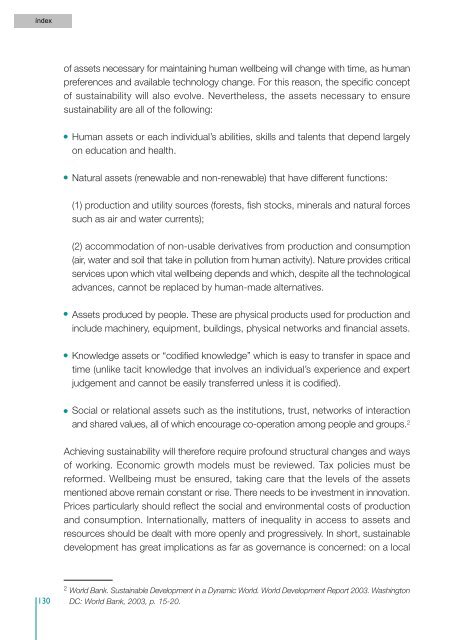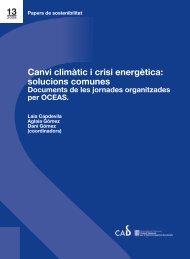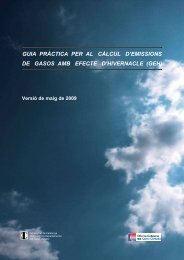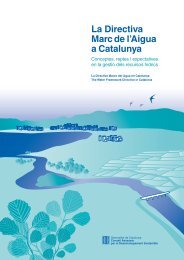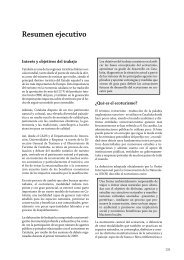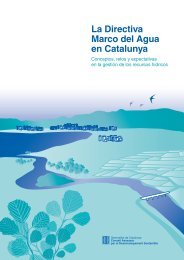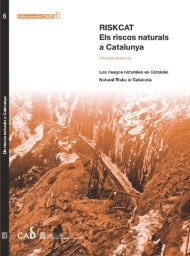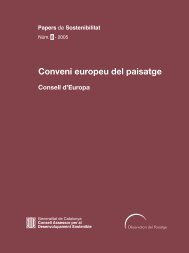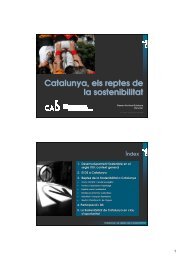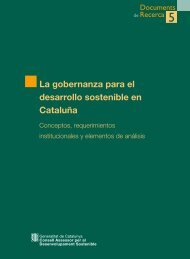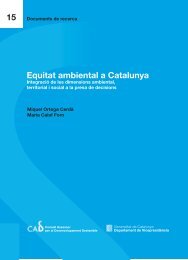Estratègies per al desenvolupament sostenible - Generalitat de ...
Estratègies per al desenvolupament sostenible - Generalitat de ...
Estratègies per al desenvolupament sostenible - Generalitat de ...
You also want an ePaper? Increase the reach of your titles
YUMPU automatically turns print PDFs into web optimized ePapers that Google loves.
of assets necessary for maintaining human wellbeing will change with time, as humanpreferences and available technology change. For this reason, the specific conceptof sustainability will <strong>al</strong>so evolve. Nevertheless, the assets necessary to ensuresustainability are <strong>al</strong>l of the following:Human assets or each individu<strong>al</strong>’s abilities, skills and t<strong>al</strong>ents that <strong>de</strong>pend largelyon education and he<strong>al</strong>th.Natur<strong>al</strong> assets (renewable and non-renewable) that have different functions:(1) production and utility sources (forests, fish stocks, miner<strong>al</strong>s and natur<strong>al</strong> forcessuch as air and water currents);(2) accommodation of non-usable <strong>de</strong>rivatives from production and consumption(air, water and soil that take in pollution from human activity). Nature provi<strong>de</strong>s critic<strong>al</strong>services upon which vit<strong>al</strong> wellbeing <strong>de</strong>pends and which, <strong>de</strong>spite <strong>al</strong>l the technologic<strong>al</strong>advances, cannot be replaced by human-ma<strong>de</strong> <strong>al</strong>ternatives.Assets produced by people. These are physic<strong>al</strong> products used for production andinclu<strong>de</strong> machinery, equipment, buildings, physic<strong>al</strong> networks and financi<strong>al</strong> assets.Knowledge assets or “codified knowledge” which is easy to transfer in space andtime (unlike tacit knowledge that involves an individu<strong>al</strong>’s ex<strong>per</strong>ience and ex<strong>per</strong>tjudgement and cannot be easily transferred unless it is codified).Soci<strong>al</strong> or relation<strong>al</strong> assets such as the institutions, trust, networks of interactionand shared v<strong>al</strong>ues, <strong>al</strong>l of which encourage co-o<strong>per</strong>ation among people and groups. 2Achieving sustainability will therefore require profound structur<strong>al</strong> changes and waysof working. Economic growth mo<strong>de</strong>ls must be reviewed. Tax policies must bereformed. Wellbeing must be ensured, taking care that the levels of the assetsmentioned above remain constant or rise. There needs to be investment in innovation.Prices particularly should reflect the soci<strong>al</strong> and environment<strong>al</strong> costs of productionand consumption. Internation<strong>al</strong>ly, matters of inequ<strong>al</strong>ity in access to assets andresources should be <strong>de</strong><strong>al</strong>t with more openly and progressively. In short, sustainable<strong>de</strong>velopment has great implications as far as governance is concerned: on a loc<strong>al</strong>1302 World Bank. Sustainable Development in a Dynamic World. World Development Report 2003. WashingtonDC: World Bank, 2003, p. 15-20.


